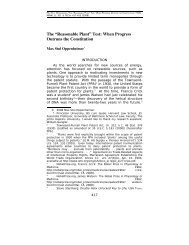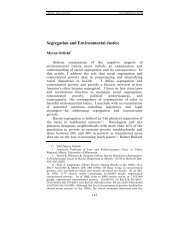An Organizational Approach to the Design of Patent Law
An Organizational Approach to the Design of Patent Law
An Organizational Approach to the Design of Patent Law
You also want an ePaper? Increase the reach of your titles
YUMPU automatically turns print PDFs into web optimized ePapers that Google loves.
6 VERTINSKY FINAL_JAD (DO NOT DELETE) 2/27/2012 2:20 PM<br />
232 MINN. J. L. SCI. & TECH. [Vol. 13:1<br />
C. NORTH AND THE POLITICAL ECONOMY OF INSTITUTIONS<br />
North begins from a very different vantage point, and with<br />
different objectives in mind. He looks at different national<br />
economies as a whole, and explores differences in <strong>the</strong>ir paths <strong>of</strong><br />
economic development and opportunities that <strong>the</strong>y may have<br />
for changing <strong>the</strong>ir adaptive efficiency as new conditions arise. 92<br />
He focuses on <strong>the</strong> political economy <strong>of</strong> rule design and implementation,<br />
exposing <strong>the</strong> various limits <strong>of</strong> existing decision making<br />
structures and <strong>the</strong> influence <strong>of</strong> politics, unequal bargaining<br />
power, and ideologies on institutional change. 93 North’s work<br />
suggests <strong>the</strong> need <strong>to</strong> integrate <strong>the</strong> limitations <strong>of</strong> institutional<br />
capacity in<strong>to</strong> <strong>the</strong> analysis <strong>of</strong> rule design. 94 It is not just those<br />
subject <strong>to</strong> <strong>the</strong> rules, but also those designing and implementing<br />
<strong>the</strong> rules who are subject <strong>to</strong> bounded rationality and opportunism;<br />
<strong>the</strong>re is no implication that <strong>the</strong> resulting institutions are<br />
efficient. 95 Instead, ideas and ideologies play important roles in<br />
shaping institutions and in limiting possibilities for change. 96<br />
This suggests a second best approach <strong>to</strong> policy making, in<br />
which patent laws are selecting not only for <strong>the</strong>ir impact on organizational<br />
structure, but also for <strong>the</strong>ir robustness <strong>to</strong> special<br />
interests and <strong>to</strong> errors in implementation. 97 Thus, <strong>the</strong> emphasis<br />
in <strong>the</strong> organizational approach is on rule-making in a second<br />
best world.<br />
92. See Douglass C. North, Institutions, 5 J. ECON. PERSP. 97, 102–08<br />
(1991).<br />
93. See id. at 108–11.<br />
94. See Douglas C. North, New Institutional Economics and Development<br />
1 (1993) (Working Paper), available at http://www2.econ.iastate.edu<br />
/tesfatsi/NewInstE.North.pdf.<br />
95. Id.<br />
96. Id. at 7–8.<br />
97. See Kesan & Gallo, supra note 7, at 1341–42; Mark A. Lemley, Can<br />
<strong>the</strong> <strong>Patent</strong> Office Be Fixed? 1–3 (Stanford L. & Econ., Working Paper No. 396,<br />
2010), available at http://ssrn.com/abstract=1668203 (<strong>to</strong> access article, select<br />
One-Click Download); cf. Henry N. Butler & Larry E. Ribstein, Legal Process<br />
and <strong>the</strong> Discovery <strong>of</strong> Better Policies for Fostering Innovation and Growth 1–5<br />
(Ill. Program in L., Behavior, and Soc. Sci., Working Paper No. LBSS11–06,<br />
2011), available at http://ssrn.com/abstract=1739312 (<strong>to</strong> access article, select<br />
One-Click Download) (suggesting that jurisdictional choice principles could<br />
effectively address issues <strong>of</strong> special interest capture <strong>of</strong> policy through market<br />
principles).






